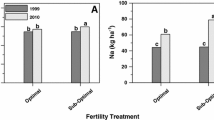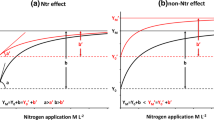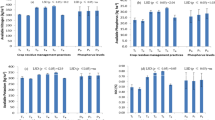Abstract
Low yields and high risk characterize many rain-fed lowland rice environments, including those in Laos. Drought and fluctuating soil-water conditions (from aerobic to anaerobic states) can limit productivity and the efficient use of applied nutrients. Although addition of organic matter may improve the efficiency of fertilizer use, on-farm residues, for example farmyard manure (FYM), rice straw and rice hulls, are, currently, poorly utilized in these systems. Single and multi-year experiments were designed to evaluate the effect of these residues on rice productivity and efficiency of fertilizer use at four sites. Rice yield without fertilizer but with addition of residues ranged from 1.1 to 1.7 t ha−1 across sites and years. In response to fertilizer, yields increased on average by 1.4 t ha−1. For all sites and years there was a significant response of yield to organic residues applied without fertilizer, with responses ranging from 0.2 to 1.4 t ha−1. In 58% of cases there was no residue×fertilizer interaction (benefits of residues when applied with fertilizer were additive). In 38 and 4% of cases the interaction was negative (no response to residues if fertilizer was already applied) or positive (synergistic), respectively. In the multi-year studies, the type of interaction varied between years, suggesting that seasonal events, rather than soil type, determine the type of interaction. The greatest benefits of applying organic and chemical fertilizers together were observed in years when soil-water conditions were unfavorable (fluctuating anaerobic–aerobic conditions). The long-term effects of these different management strategies on soil nutrient balances suggest that N, P, and K balances were maintained as a result of balanced commercial fertilizer management but that addition of residues further enhanced these balances. All residues, when applied alone, resulted in positive soil Si balances; only with FYM were long-term N, P, and K balances maintained or positive, however. For resource-poor farmers, applying on-farm residues can be a sustainable approach to increasing productivity.






Similar content being viewed by others
References
Bell RW, Seng V (2004) Rain-fed lowland rice-growing soils of Cambodia, Laos and Northeast Thailand. In: Seng V, Craswell E, Fukai S, Fisher K (eds) Water in agriculture, pp 161–173. ACIAR Proceedings 116
Bellakki MA, Badanur VP, Setty RA (1998) Effect of long-term integrated nutrient management on important properties of a vertisol. J Indian Soc Soil Sci 46:176–180
Bird JA, Horwath WR, Eagle AJ, van Kessel C (2001) Immobilization of fertilizer nitrogen in rice: effects of straw management practices. Soil Sci Soc Am J 65:1143–1152
Broadbent FE, Nakashima T (1970) Nitrogen immobilization in flooded soils. Soil Sci Soc Amer Proc 34:218–221
Buresh RJ, De Datta SK (1991) Nitrogen dynamics and management in rice-legume cropping systems. Adv Agron 45:1–59
Cassman KG, Gines GC, Dizon MA, Samson MI, Alcantara JM (1996) Nitrogen-use efficiency in tropical lowland rice systems: contributions from indigenous and applied nitrogen. Field Crops Res 47:1–12
Chabalier P (1987) Rice. In: Martin-Prevel P, Gagnard J, Gautier P (eds) Plant analysis as a guide to the nutrient requirements of temperate and tropical crops. Lavoisier Publishing Inc., New York, pp 526–530
Cox FR, Uribe E (1992) Management and dynamics of potassium in a humid tropical ultisol under a rice-cowpea rotation. Agron. J. 84:655–660
De Datta SK (1981) Principles and practices of rice production. John Wiley, New York, pp 618
Dierolf TS, Yost RS (2000) Stover and potassium management in an upland rice-soybean rotation on an Indonesian ultisol. Agron J 92:106–114
Dobermann A, Sta Cruz PC, Cassman KG (1996) Fertilizer inputs, nutrient balance, and soil nutrient-supplying power in intensive, irrigated rice systems. I. Potassium uptake and K balance. Nutr Cycling Agroeco 46:1–10
Dobermann A, Cassman KG, Mamaril CP, Sheehy JE (1998) Management of phosphorus, potassium, and sulfur in intensive irrigated lowland rice. Field Crops Res 56:113–138
Dobermann A, Fairhurst T (2000) Rice: nutrient disorders and nutrient management. Singapore and Los Baños, Potash & Phosphate Institute (PPI), Potash & Phosphate Institute of Canada (PPIC), and International Rice Research Institute (IRRI), 191 pp
Dobermann A, White PF (1999) Strategies for nutrient management in irrigated and rain-fed lowland rice systems. Nutr Cycl Agroecosyst 53: 1–18
Friesen DK (1991) Fate and efficiency of sulfur fertilizer applied to food crops in West Africa. Fert Res 29:35–44
Fukai S, Sittisuang P, Chanphengsay M (1998) Increasing production of rain-fed lowland rice in drought prone environments––a case study of Thailand and Laos. Plant Prod Sci 1:75–82
Gill DW, Kamprath EJ (1990) Potassium uptake and recovery by an upland rice-soybean rotation on an Oxisol. Agron J 82:329–333
Gomez KA, Gomez AA (1984) Statistical procedures for agricultural research. John Wiley & Sons, New York
Heathcote RG (1970) Soil fertility under continuous cultivation in northern Nigeria. II. Response to fertilizer in the absence of organic manures. Exp Agric 6:345–350
Heefele SM, Naklang K, Harnpichitvitaya D, Jearakongman S, Skulkhu E, Romyen P, Phasopa S, Tabtim S, Suriya-arunroj D, Khunthasuvon S, Kraisorakul D, Youngsuk P, Amarante ST, Wade LJ (2006) Factors affecting rice yield and fertilizer response in rain-fed lowlands of northeast Thailand. Field Crops Res 98:39–51
Juliano BO, Bechtel DB (1985) The rice grain and its gross composition. In: Juliano B.O. (ed) Rice: Chemistry and technology, 2nd edn. St. Paul, Minnesota. American Association of Cereal Chemists. AACC monograph series, 774 p
Kirk GJD (2004) The biogeochemistry of submerged soils. Wiley Science, Chichester, UK
Lao-IRRI. (1995) Annual Technical Report, 296 p
Linquist BA, Sengxua P, Whitbread A, Schiller J, Lathvilayvong P (1998) Evaluating nutrient deficiencies and management strategies for lowland rice in Lao PDR. In: Ladha J.K, Wade L.J, Dobermann A, Reichardt W, Kirk G.J.D, Piggin C. (eds) Rain-fed lowland rice: advances in nutrient management research. Proceedings of the international workshop on nutrient research in rain-fed Lowlands, 12–15 Oct. 1998, Ubon Ratchathani, Thailand
Linquist BA, Sengxua P (2001) Nutrient management in rain-fed lowland rice in the Lao PDR. Los Banos, Philippines, International Rice Research Institute, p 88
Linquist BA, Sengxua P (2003) Efficient and flexible management of nitrogen for rain-fed lowland rice. Nutr Cycling Agroecosyst 67:107–115
Linquist BA, Brouder SM, Hill JE (2006) Winter straw and water management effects on soil nitrogen dynamics in California rice systems. Agron J 98: 1050–1059
Maclean JL, Dawe DC, Hardy B, Hettel GP (eds) (2002) Rice Almanac, 3rd edn. Los Banos (Philippines): International Rice Research Institute, Bouake (Cote d’Ivoire): West Africa Rice Development Association, Cali (Colombia): International Center for Tropical Agriculture, Rome (Italy): Food and Agriculture Organization, 253 pp
Pandey S, Sanamongkhoun M (1998) rain-fed lowland rice in Laos: a socio-economic benchmark study. International Rice Research Institute, Los Banos, Philippines
Ponnamperuma F (1972) The chemistry of submerged soils. Adv Agron 24:29–97
Prasad R, Gangaiah B, Aipe KC (1999) Effect of rice crop residue management in a rice-wheat cropping system on growth and yield of crops and on soil. Exp Agric 35:427–435
Ragland J, Boonpuckdee L (1988) Fertilizer responses in NE Thailand. 3. Nitrogen use and soil acidity. Thai J Soils Fert 10:67–76
Rao DN, Mikkelsen DS (1976) Effect of rice straw incorporation on rice plant growth and nutrition. Agron J 6:752–755
Savant NK, Snyder GH, Datnoff LE (1997) Silicon management and sustainable rice production. Adv Agron 58:151–199
Seng V, Bell RW, Willet IR (2004) Amelioration of growth reduction of lowland rice caused by a temporary loss of soil-water saturation. Plant Soil 265:1–16
Schnier HF, De Datta SK, Mengel K (1987) Dynamics of 15N labeled ammonium sulfate in various inorganic and organic soil fractions of wetland rice soils. Biol Fertil Soils 4:171–177
Shapiro SS, Wilk M (1965) An analysis of variance test for normality. Biometrika 52:591–611
Supapoj N, Naklang K, Konboon Y (1998) Using organic material to improve soil productivity in rainfed lowland rice in Northeast Thailand. In: Ladha JK, Wade LJ, Dobermann A, Reichardt W, Kirk GJD, Piggin C (eds) rain-fed lowland rice: advances in nutrient management research. Proceedings of the international workshop on nutrient research in rain-fed Lowlands, 12–15 Oct. 1998, Ubon Ratchathani, Thailand
Surekha K, Padma Kumari AP, Narayana Reddy M, Satyanarayana K, Sta Cruz PC (2003) Crop residue management to sustain soil fertility and irrigated rice yields. Nutr Cycling Agroecosyst 67:145–1544
Van Asten PJA, van Bodegom PM, Mulder LM, Kropff MJ (2005) Effect of straw application on rice yields and nutrient availability on an alkaline and a pH-neutral soil in a Sahlian irrigation scheme. Nutr Cycling Agroecosyst 72:255–266
Wade LJ, Amarante ST, Olea A, Harnpichitvitaya D, Naklang K, Wihardjaka A, Sengar SS, Mazid MA, Singh G, McLaren CG (1999) Nutrient requirements in rain-fed lowland rice. Field Crops Res 64:91–107
Willet IR (1995) Role of organic matter in controlling chemical properties and fertility of sandy soils used for lowland rice in Northeast Thailand. In: Lefroy R.D.B, Blair G.J, Craswell E.T. (eds) Soil organic matter management for sustainable agriculture: a workshop held in Ubon, Thailand, 24–26 August 1994. ACIAR Proceedings No. 56, 163 p
Wihardjaka A, Kirk GJD, Abdulrachman S, Mamaril CP (1999) Potassium balances in rain-fed lowland rice on a light-textured soil. Field Crops Res 64:237–247
Williams WA, Mikkelsen DS, Mueller KE, Ruckman JE (1968) Nitrogen immobilization by rice straw incorporated in lowland rice production. Plant Soil 28:49–60
Witt C, Cassman KG, Ottow JCG, Biker U (1998) Soil microbial biomass and nitrogen supply in an irrigated lowland rice soil as affected by crop rotation and residue management. Biol Fertil Soils 28:71–80
Witt C, Cassman KG, Olk DC, Biker U, Liboon SP, Samson MI, Ottow JCG (2000) Initial effects of crop rotation and residue management on carbon sequestration, nitrogen cycling, and productivity of irrigated rice systems. Plant Soil 225:263–278
Zeigler RS, Puckridge DW (1995) Improving sustainable productivity in rice-based rain-fed lowland systems of South and Southeast Asia. Feeding 4 billion people. The challenge for rice research in the 21st century. GeoJournal 35:307–324
Acknowledgements
The authors would like to thank the Lao Ministry of Agriculture and the Swiss Agency for Development and Cooperation (SDC) for the support of this research.
Author information
Authors and Affiliations
Corresponding author
Rights and permissions
About this article
Cite this article
Linquist, B.A., Phengsouvanna, V. & Sengxue, P. Benefits of organic residues and chemical fertilizer to productivity of rain-fed lowland rice and to soil nutrient balances. Nutr Cycl Agroecosyst 79, 59–72 (2007). https://doi.org/10.1007/s10705-007-9095-5
Received:
Accepted:
Published:
Issue Date:
DOI: https://doi.org/10.1007/s10705-007-9095-5




